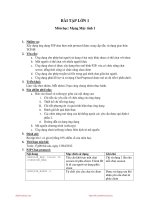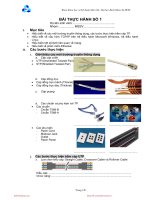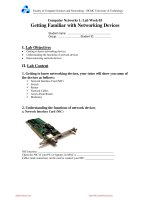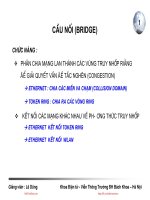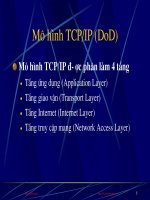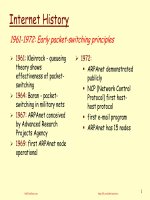mạng máy tính05a routing subnet sinhvienzone com
Bạn đang xem bản rút gọn của tài liệu. Xem và tải ngay bản đầy đủ của tài liệu tại đây (8.45 MB, 85 trang )
Networking Basics
ROUTING
FUNDAMENTALS
AND
SUBNETS
Version 3.0
Cisco Regional Networking Academy
SinhVienZone.com
/>
Objectives
• Describe routed (routable) protocols.
• List the steps of data encapsulation in an internetwork as
•
•
•
•
•
•
•
•
data is routed to one or more Layer 3 devices.
Describe connectionless and connection-oriented delivery.
Name the IP packet fields.
Describe process of routing.
Compare and contrast different types of routing protocols.
List and describe several metrics used by routing protocols.
List several uses for subnetting.
Determine the subnet mask for a given situation.
Use a subnet mask to determine the subnet ID.
SinhVienZone.com
/>
Table of Content
1
Internet Protocol – Routed
2
IP Routing Protocols
3
Mechanics of Subnetting
SinhVienZone.com
/>
INTERNET PROTOCOL - ROUTED
SinhVienZone.com
/>
Routable and routed protocols
SinhVienZone.com
/>
Routable and routed protocols
• A protocol is a set of rules that determines
how computers communicate with each other
across networks.
• A routed protocol allows the router to
forward data between nodes on different
networks.
• In order for a protocol to be routable, it must
provide the ability to assign a network
number and a host number to each individual
device.
SinhVienZone.com
/>
IP as a routed protocol
• The Internet Protocol (IP) is the most widely
used implementation of a hierarchical networkaddressing scheme.
• IP is a connectionless, unreliable, best-effort
delivery protocol.
• At the network layer, the data is encapsulated
within packets (also known as datagrams).
• Packet includes header - addressing and other
control information + actual data - whatever is
passed down from the higher layers.
SinhVienZone.com
/>
Packet propagation and switching within a router
SinhVienZone.com
/>
Router protocol stripping
SinhVienZone.com
/>
Router protocol stripping (cont.)
SinhVienZone.com
/>
Connection oriented network services
• A connection is established between the
sender and the recipient before any data
is transferred.
SinhVienZone.com
/>
Circuit switched
• Connection-oriented network processes are often
referred to as circuit switched.
• These processes establish a connection with the
recipient, first, and then begin the data transfer.
• All packets travel sequentially across the same
physical circuit, or more commonly, across the
same virtual circuit.
SinhVienZone.com
/>
Connectionless network services
• They treat each packet separately.
• IP is a connectionless system.
SinhVienZone.com
/>
Packet switched
• Connectionless network processes are often
referred to as packet switched.
• When the packets pass from source to
destination, they can:
– Switch to different paths.
– Arrive out of order.
• Devices make the path determination for each
packet based on a variety of criteria. Some of the
criteria may differ from packet to packet.
SinhVienZone.com
/>
Anatomy of an IP packet
SinhVienZone.com
•www.ietf.org and RFC-760
/>
IP header format: Version
• 4 bits.
• Indicates the version of
IP currently used.
– IPv4 : 0100
– IPv6 : 0110
SinhVienZone.com
/>
IP header format: Header length
• 4 bits.
• IP header length : Indicates the datagram
header length in 32 bit words (4 bits).
• The value of this field is 5 (5x4)byte, and
15 (15x4)byte
SinhVienZone.com
/>
IP header format: Service type
• How the datagram should be handled by the routers.
• Specifies the level of importance that has been
assigned by a particular upper-layer protocol.
• 8 bits:
• Precedence (3 bits) not use in version 4
• Service Type (4 bits) (Link to TOS)
• Unused (1 bit)
SinhVienZone.com
/>
IP header format: Total length
• Specifies the length of the entire IP packet,
including data and header, in bytes.
• 16 bits., so 216-1 = 65,535 bytes
SinhVienZone.com
/>
IP header format: Identification
• 16 bits.
• Used to distinguish the fragments of one
datagram from those of another
• Assigned by the sender to help the
destination in reassembling the datagram
fragments.
SinhVienZone.com
/>
IP header format: Flags
• 3 bits.
• Bit 0: reserved, must be zero, unused
• Bit 1: Don't Fragment This Datagram (1)
or Fragment if necessary (0)
• Bit 2: More Fragments Flag (1) or Last (0)
SinhVienZone.com
/>
IP header format: Fragment offset
• 13 bits
• Tells the receiver the position of a fragment in the
original datagram
• The fragment offset is measured in units of 8 bytes
(Position number / 8)
• The first fragment has offset zero.
• The last fragment has flags zero.
SinhVienZone.com
/>
IP header format: Time to Live
• 8 bits.
• Time-to-Live maintains a counter that
gradually decreases to zero, at which point
the datagram is discarded, keeping the
packets from looping endlessly.
SinhVienZone.com
/>
IP header format: Protocol
• 8 bits.
• Indicates which upper-layer protocol receives
incoming packets after IP processing has
been completed
• 06 : TCP
• 17 : UDP
SinhVienZone.com
01 : ICMP
08 : EGP
/>
IP header format: Header checksum
• 16 bits.
• A checksum on the header only,
helps ensure IP header integrity.
SinhVienZone.com
/>


